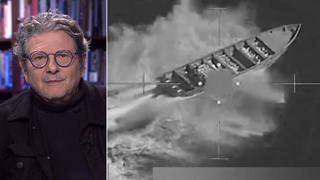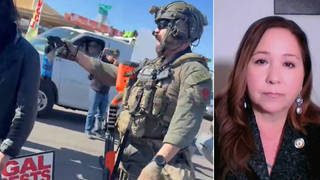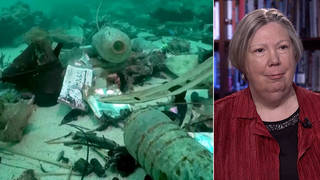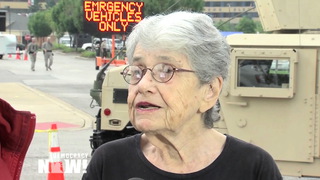
Topics
Guests
- James Hayesfounding member of the Ohio Student Association, which has been organizing protests around the shooting of John Crawford.
- Rashad Robinsonexecutive director of Color of Change.
An Ohio grand jury has declined to indict the white police officer who fatally shot John Crawford. A 22-year-old African American, Crawford was killed inside a Wal-Mart store last month after a caller phoned police to accuse him of brandishing a gun and pointing it at other customers. In fact, Crawford had picked up an unloaded BB air rifle on a shelf, an item that is sold in the store. Newly released surveillance footage shows major discrepancies between a 911 caller’s account, and what really happened. The Justice Department now says it will launch a federal review to determine if Crawford’s civil rights were violated. We are joined by two guests: Rashad Robinson, executive director of Color of Change, a national organization that has campaigned for Wal-Mart to release the surveillance tapes, and James Hayes, founding member of the Ohio Student Association, which has been organizing protests over the shooting.
Transcript
JUAN GONZÁLEZ: We turn now to Ohio, where a grand jury has declined to indict a white police officer who shot and killed a 22-year-old African-American man named John Crawford. On August 5th, four days before the unarmed black teenager Michael Brown was fatally shot by police in a case that ignited the country, John Crawford walked into a Wal-Mart in Beavercreek, Ohio. According to his girlfriend, the two went to the store to buy supplies for making s’mores at a cookout. As he walked around the store, talking on his cellphone, Crawford picked up an unloaded BB air rifle that was lying on a shelf.
AMY GOODMAN: Surveillance footage released Wednesday, following the grand jury’s decision, shows what happened next. As Crawford stands in the pet supplies aisle talking on his cellphone, a customer calls 911. In this footage, the 911 call has been synced with the surveillance footage.
911 OPERATOR: Beavercreek 911. Where is your emergency?
RONALD RITCHIE: I’m at the Beavercreek Wal-Mart. There is a gentleman walking around with a gun in the store.
911 OPERATOR: Has he got it pulled out?
RONALD RITCHIE: Yeah, he’s like pointing it at people.
911 OPERATOR: What does he look like?
RONALD RITCHIE: He’s a black male, probably about six-foot tall.
911 OPERATOR: OK. What’s he wearing?
RONALD RITCHIE: Blue shirt, blue pants.
JUAN GONZÁLEZ: While the caller, Ronald Ritchie, claims Crawford is pointing the gun at people, the surveillance footage shows he’s pointing the gun at the ground, occasionally swinging it and prodding supplies on a shelf in front of him. Ritchie later acknowledged to The Guardian, quote, “At no point did he shoulder the rifle and point it at somebody.”
AMY GOODMAN: Minutes into the call, Ritchie tells a dispatcher Crawford is pointing the gun at two children. The surveillance footage shows that while a woman and two children appear at the end of the same aisle, Crawford never actually points the gun at them.
911 OPERATOR: He’s a black male, black shirt and blue jeans?
RONALD RITCHIE: Yes.
911 OPERATOR: Does he have a hat or anything on?
RONALD RITCHIE: No, he’s got like an Afro.
911 OPERATOR: An Afro? Beavercreek, did you get that?
POLICE OFFICER: I got that. Heading after.
RONALD RITCHIE: I hear police. And he just pointed—
911 OPERATOR: What is your name again, sir?
RONALD RITCHIE: My name’s Ronald Ritchie. He just pointed it at like two children.
AMY GOODMAN: Just over a minute later, police appear in the footage. In the span of about a second, police can be heard shouting at Crawford and shooting him twice. Crawford is facing to the side, with the BB gun swinging loosely toward the ground. As the officers advance, he appears to bend his knees.
911 OPERATOR: Sir, what’s going on?
RONALD RITCHIE: Gunshots in the store. Police officers are here. They’re on the scene.
JUAN GONZÁLEZ: Crawford collapses, and police move to restrain him. He was taken to a hospital but died of his wounds. LeeCee Johnson, the mother of Crawford’s two young children, said she was on the phone with him and heard him tell police, “It’s not real.” She put the call on speakerphone, and John Crawford’s father, who was with Johnson at the time, said he heard his son gasping for air. He told the Cincinnati Enquirer, “I’m virtually listening to my kid taking his last breath.”
AMY GOODMAN: Another woman also lost her life that day at the Wal-Mart. In the panic that ensued amidst the police advance, a customer named Angela Williams, the one shown earlier in the pet aisle shopping with her two young children, went into cardiac arrest and died.
Well, on Wednesday, a special grand jury concluded police were justified in shooting John Crawford. At a news conference, the special prosecutor who handled the case, Mark Piepmeier, acknowledged that without Ronald Ritchie’s 911 call, the shooting never would have happened.
MARK PIEPMEIER: We’ve got a caller who I think, for the most part, saw what he said on the 911 call. Some of the things he said on the 911 call, maybe he was trying to fill in some gaps in what he saw, but he very clearly tells the 911 operator, “I’m in a Wal-Mart. There’s a guy in here with an assault rifle. He’s loading it, and he’s pointing it at people.” And this is what is communicated to the police officers. But one officer even calls back in, and he’s basically, “Wait a minute. Are you saying he’s actually pointing it at people?” And they say, “Yes.” And the law is real clear. When you’re a police officer responding to the scene, it’s not what is true or not true, it’s what you reasonably believe to be true. And there’s no reason for these officers not to believe that’s what’s going on.
AMY GOODMAN: The Justice Department says they’ll review the shooting.
To talk more about the case, we’re joined by two guests. In New York, Rashad Robinson is with us, executive director of Color of Change, a national organization that’s been calling for weeks for Wal-Mart to release the surveillance tapes. And in Columbus, Ohio, James Hayes is founding member of the Ohio Student Association, which has been organizing protests over the shooting of John Crawford.
We welcome you both to Democracy Now! John, let’s go to you first—James, let’s go to you first in Columbus. Talk about your reaction to the grand jury not finding the police officers guilty in the shooting.
JAMES HAYES: Well, first, thank you all for having me on the show. You know, many of us were present while they were making the announcement, and to be honest, none of us were shocked. For weeks, the family has been asking for the Department of Justice to open their own investigation, because the writing was on the wall that the grand jury would return with no indictment. The last time that Beavercreek, Ohio, was in national news, they were fighting the regional transit authority from putting a bus stop near their mall that would allow residents from Dayton to access the mall, people who work there, people who shop there. You know, we already know how Greene County jurors vote. There’s just this good ol’ boys’ network and this—many conflicts of interest which, we understood, made it unlikely that an indictment would be found.
So we weren’t surprised, but we were very saddened. We were very saddened that the jury was unable to indict these officers, unable to push this case forward for a jury trial, saddened that the prosecutor didn’t really attempt to prosecute this officer, but instead seemed to be justifying the decisions, trying to figure out how to show that there was no one at fault. But we—while being saddened, we understand that we must push forward, and it only strengthens our resolve to fight for justice for John, his family, and to fight for true systemic change that will make sure that there are fewer and fewer John Crawfords.
JUAN GONZÁLEZ: And, James Hayes, why did it take so long for this video to come out, after the grand jury decision? Clearly, everyone knew that there had to be surveillance cameras inside the Wal-Mart that might have captured some of these events.
JAMES HAYES: That’s something we’ve been asking for since a week after John was killed: Release the tape. Our first round of actions, we had an action in Cleveland. We had a march in Beavercreek, where about 200 protesters went to the Beavercreek police station. And that round of protests culminated in an action at our Ohio Attorney General Mike DeWine’s office. The day after that, Mike DeWine allowed the family and the lawyers to see about six minutes of the footage from the Wal-Mart security cameras. Afterwards, the family said, “Our son was murdered.” And we were pushing for a public release, but we were told that it could take up to two to three years for that tape to be released, when we initially went and spoke with representatives from Mike DeWine’s office.
It’s clear that they knew if they released the tape before the jury made its decision, that the public was going to come to a decision before them. And everyone who’s seen the tape, it’s resonating across the country right now. People are seeing that John Crawford had absolutely no time to respond to the officers. They entered the store at 8:25, and by 8:27, John Crawford was on the ground with two bullets inside of his body. And I honestly think that they knew that they were going to not try to really indict this officer, and they didn’t want the public to indict him before the grand jury had an opportunity to make their decision.
AMY GOODMAN: The Crawford family’s attorney, Michael Wright, reacted to the grand jury’s decision in a statement that said, quote, “Rather than advocate for the constitutional rights of John Crawford, III and Angela Williams, the other victim in this case, Attorney General DeWine and Special Prosecutor Mark Piepmeier made excuses for the officer’s actions and have erroneously argued the officer’s actions were 'reasonable'.” The statement continued, quote, “The Crawford family feels they have been victimized all over again and once again request that the U.S. Department of Justice conduct an independent investigation into the tragic death of John H. Crawford, III.” This is John Crawford’s girlfriend, LeeCee Johnson, who was on the phone with Crawford—this is the mother of his two children—when police shot him.
LEECEE JOHNSON: I just heard them just shoot him like he wasn’t nothing. He was just telling them that it wasn’t real. And he didn’t even give him a chance to respond. They just shot.
AMY GOODMAN: “It’s not real.” Johnson says those were Crawford’s last words. Crawford’s father says he heard his son’s last moments on speakerphone. He later watched the surveillance video showing his death and described what he saw.
JOHN CRAWFORD JR.: That was just unbelievable. That’s all I could tell to you. I pray that no one ever, ever has to go through what we’re going through. It’s unconscionable. You know, I saw my son getting murdered.
AMY GOODMAN: We’re going to turn now to Special Prosecutor Mark Piepmeier describing how the police officer who shot Crawford responded to the 911 call.
MARK PIEPMEIER: I mean, again, you could see how serious this was, because he gets out of his car, puts his regular service piece in the trunk, gets out an assault rifle. The other officer shows up, does the same thing—puts on his tactical vest, gets his assault rifle. So it’s very obvious from what they did they thought this was the real deal. And then they’re beating feet in there; they’re not just walking around. You can see as they’re coming in. I mean, it looks like a combat picture. And that’s what these guys were taught. That’s how they’re taught to approach this kind of thing.
AMY GOODMAN: Special Prosecutor Mark Piepmeier acknowledged the police response might have been a little bit over the top. James Hayes, who is Special Prosecutor Piepmeier?
JAMES HAYES: Well, in Ohio, we know Mark Piepmeier as the prosecutor who failed to bring justice in the Timothy Thomas trial, which, before the events in Ferguson, was the last time there was an uprising in an American city around race relations. We know him as the prosecutor who sent the inmates in Lucasville prison uprising to death row. When he was appointed, it was clear that this was not a good sign for what would happen in Greene County, and it was more fuel to the fire in terms of trying to bring the Department of Justice in to open their own investigation.
JUAN GONZÁLEZ: And what about the context of this happening in Greene County? For listeners and viewers around the country, tell us a little bit about Greene County.
JAMES HAYES: Well, as I said earlier, you know, the last time that Beavercreek, Ohio, was in national news, they were trying to keep black people out of their city, trying to keep black people from shopping in their mall, trying to keep the black people who work in their mall from having an easy access through public transit. You know, Greene County is a place where, in the ’30s and ’40s and even before that, many Southerners were moving up for job opportunities, working at the Air Force base in the area. And those mentalities and attitudes are still prevalent.
You know, our attorney general, Mike DeWine, is from Greene County. He grew up there and began his political career there as a prosecutor. His daughter is currently a prosecutor there. There’s a good ol’ boys network that has power in the county still to this day. And, you know, it’s clear that the nepotism and the conflicts of interest in this case are especially ripe.
Officer Williams, the shooter, the man who killed John Crawford, his father was also on the Beavercreek police force, you know, and so it’s no surprise that he’s receiving special treatment. I mean, this is the second time that Officer Williams has killed somebody in Greene County in the last four years. So it’s pretty clear that he should not be a police officer. I mean, if a Wal-Mart employee misses two shifts, they’re going to be fired. So, you know, even if this was the most genuine, honest mistake, it’s pretty clear that this officer should be let go and try to find something else that he can do better.
But Greene County is a place where we were always worried that we would be unable to find justice. It’s a place—and it’s one of the reasons that led to us wanting to make the pilgrimage, make the journey, from the Wal-Mart where John Crawford was killed to the courthouse in Xenia, walking through those back roads in through Greene County so we could, in our action, not only bring attention from around the country to Greene County, but give an opportunity for us to show the residents of Greene County, those who are with us and those who are against us, that people are willing to take action in this case.
AMY GOODMAN: James Hayes is speaking to us from Columbus, Ohio, Rashad Robinson here in New York, executive director of Color of Change, usually in the Bay Area. Wal-Mart is the largest retailer of rifles in the country.
RASHAD ROBINSON: Absolutely. They have spent years lobbying for looser gun laws in this country. You know, partnering with the American Legislative Exchange Council, they actually wrote the “Stand Your Ground” law, which became famous during the Trayvon Martin tragedy, and pushed that law, along with the NRA, to about 26 states around the country. They are the largest seller of rifles and guns in this country, and they’re also the largest employer of black people and women in this country.
And so, to the extent that—you know, part of our campaign was really focusing on what is Wal-Mart’s social responsibility in this. How are they going to sort of hide behind what’s happening and not release those tapes? There were over 200 cameras in that store. And we had to wait weeks and weeks for any sense of understanding of what happened. So, for customers, for black folks who are shopping in Wal-Mart and working in Wal-Mart, what can they expect from this giant about their safety?
JUAN GONZÁLEZ: And obviously, the fact that those tapes were not released until now, when this occurred even before the shooting in Ferguson, shows that this would have created an even bigger national furor if those tapes had come out at that time.
RASHAD ROBINSON: Absolutely. I mean, here’s what’s happening, all around the country. You know, at Color of Change, we continue to hear the stories from our members. We continue to see these issues bubble up over and over and over again, where black people are harmed, are put—or killed by police officers, and there’s no sense of justice, no sense of accountability. The fact of the matter is, is that for black parents, for people who are family members or care about black people, the idea that we can expect any sense of justice or any sense of safety from our law enforcement figures, that we can call 911 and expect the law enforcement figures to show up and protect us and see our lives as valuable and with humanity—Ohio has open-carry laws. Part of that has been pushed by the NRA. So, John—
AMY GOODMAN: Which are?
RASHAD ROBINSON: Which open-carry laws means that you can carry a gun around openly in the state of Ohio. You can carry a gun into Wal-Mart. So, in fact, even if he did have the gun in the store, he was not breaking the law. These laws do not protect black people, because police officers are not trained to see black people as human. And this is an ongoing problem, and all of us have to be deeply concerned.
AMY GOODMAN: You were in Ferguson. The key point in both these cases, Piepmeier laid it out: It’s not the truth that matters, it’s what the police officers believed. And they saw that area as a combat zone—Michael Brown, too, on the street, how the police officer saw him.
RASHAD ROBINSON: It’s absolutely about sort of this racism and implicit bias that exist in our society. And also, the fact of the matter is that police are allowed to investigate themselves, that we have this political system where prosecutors have no incentive, where the victims are black and the police officers are white, to prosecute vigorously. We saw this press conference, and we saw the press conferences coming out of Ferguson. Right from the start in both of those situations, we saw that the decks were stacked against justice, that there was sort of not going to be a sense of fairness, that there was not going to be a sense of fair play for the victims in these cases. And the fact of the matter is, is that the video not being released, the political apparatus in Ohio had weeks to criminalize John Crawford in death, the same way that Michael Brown was criminalized in death, that we’re releasing all sorts of information, and we’re trying to create a sense of doubt in the community’s mind, and so when these cases go to the grand jury, when they go to the community, that folks have sort of this understanding that these are not people that deserve our sympathy, that deserve to be seen as victims.
JUAN GONZÁLEZ: James Hayes, I wanted to ask you one other point. As I understand it, initial press reports indicated there were multiple 911 calls to the police, and it turned out that there was really only one 911 call to the police, the one that we featured earlier on. Is that accurate?
JAMES HAYES: Absolutely accurate. The only—there were multiple 911 calls, but the only one before officers entered the store and fired shots was by Ronald Ritchie.
AMY GOODMAN: Well, on that note, I want to thank you both for being with us. Here in New York, Rashad Robinson is the executive director of Color of Change. James Hayes, with us in Columbus, founding member of the Ohio Student Association, which has been organizing protests around the shooting of John Crawford, holding a BB gun in a Wal-Mart store that he had picked up off the shelf, talking on the phone at the time, and as the police came in, saying, “It’s not real. It’s not real.”
This is Democracy Now! When we come back, we’ll be joined by Abdullah Elshamy. He is the Al Jazeera reporter who was held for more than 10 months in prison in Egypt. Stay with us.












Media Options